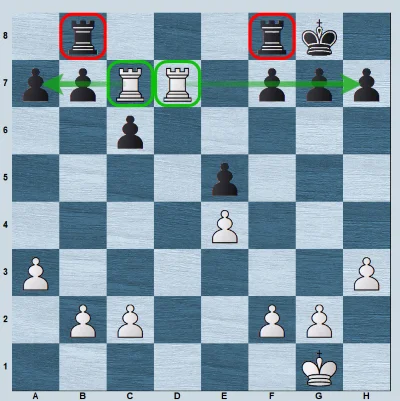Open Files: How to Exploit them
It’s said that “Rooks belong on open files” – but actually there’s a lot more to it! See GM Gabuzyan teach the key concepts and ideas behind using open files.
It’s said that “Rooks belong on open files” – but actually there’s a lot more to it! See GM Gabuzyan teach the key concepts and ideas behind using open files.

Grandmasters understand the importance of open files.
When you watch their games you’ll often see how they take control of them, paralyze their opponents' pieces, and infiltrate into their camp.
It’s this powerful positional concept I want to teach you today.
What might seem simple on the surface, is actually much more advanced.
Sometimes open files are useless for your Rooks.
Sometimes there will be more than one open file on the board and you’ll need to decide which file to fight for.
And once you gain control of an open file, you need to know how to convert this into a win, by following ideas like piling Rooks on the 7th or 8th rank.
Before we look at some of the more advanced concepts, let’s start with a basic principle – why controlling open files is important in the first place!
In the position below, we see an open c-file:

If it’s White to move we play 1.Rc1

Now the White Rook will become very active, with the option to go to the 7th rank and attack Black’s pawns, as well force Black’s Rook and King to protect the pawns.
If at the beginning position, it’s Black to move 1...Rc8 will bring the same benefits to Black.
That was a simple position, now let’s look at a practical one. It’s White to move. What’s the evaluation and what would you play?

Since White has control over the d-file, they have the advantage. Logically we play 1.Rd3 and try to double up.

In this example, Black can’t fight for the open file with 1...Rd8 since there is 2.Ng5 and the pawn on f7 will hang.
On the next move, White will double up and due to their control of the open file, will obtain a huge advantage.
Now let’s look at one of the main benefits of controlling the open file – gaining control over the 7th rank. Whenever we have our heavy pieces on the 7th rank, our opponents will suffer.
For example, compare the White and Black Rooks in the position below:

It doesn’t take a genius to see that White’s Rooks are far more active.
Not only does White control the open D-file, but their control over the 7th rank allows them to attack Black’s pawns and paralyze Black’s Rooks. The difference will prove decisive.
Let’s take a look at the next practical example.
It’s White to move. Can you find the move and the idea behind it?

We have great control over two open files. Now is a good time to control the 7th rank as well. White plays:
1.Qa7 Rf8 2.Rb7 Bb2 3.Rcc7

In a few moves, White got a monster set-up. Tripled up heavy pieces on the 7th rank. Ouch! White’s position is just winning.
Accessing the 7th rank is one very important benefit of controlling open files, now let’s take a look at another...
Fun fact: A Rook on the 8th rank without space for the King to escape is checkmate! 🙂

This means if the 7th rank is good for taking pawns and making our opponent’s pieces passive, then the 8th rank is good for checks and dangerous threats.
In the position below, White is 2 pawns down. The last move of Black was Rxa2. Should we just admit we are in a very tough spot or can we find a way to win?

1.Rd8!
Ignoring the fact that the Queen is under attack and creating a checkmate threat due to the weakness of the 8th rank. If Black plays 2... Rf8 3.Rxf8 Kxf8 4.Qd8 is a checkmate too.
And if Black tries to play 1...Qa4 to protect the Rook 2.Qxa2!! finishes the game:

Black’s Queen isn’t able to take on a2 while keeping an eye on the e8 square. White is winning.
Sometimes through the 8th rank, we can paralyze our opponent’s pieces and prevent them from developing.
In the position below it’s White to move. The pawn on f5 is hanging. What would you play?

We can take the pawn on f5, but it’s much stronger to play:
1.Rd1!
White brings the Rook to the d8 square and prevents the Black Knight from jumping to d7.
After 1...g6 2.Rd8

Black’s pieces are paralyzed. White’s easily winning with the idea of Nd5-Nc7.
At this point, you might think that whenever there’s an open file, we should fight for it, right? Now let’s go to the next part – I have a surprise for you...
In some situations, we will ignore open files and even leave them to our opponent. Take a look at the position below and try to find a good continuation for Black:

Did you think about playing 1...Rh8 and trying to fight for control over the h-file?If we take a closer look we can see that the Black King is controlling all the important squares. This means the White Rook on h1 is basically doing nothing.
Also, we can make better use of our Rook on the b-file. After 1...Rb8 2.a3 a5

Black is going to play b4, open up the b-file and create pawn weakness on the c3 square. Black is slightly better.
From this example, we can deduce that entry squares are very important when thinking about the use of open files.
In order to make the most of open files, we need entry squares for our heavy pieces.
In the position below, White has 3 entry squares for the Rook – d6, d7, and d8:

White has clear access to all the doors of Black’s position.
Let’s make a few changes:

Now Black’s King covers the important squares and the open file becomes far less valuable.
Lastly, what if we remove the “b” pawns?

Now if we play Rd1 all the entry squares will be covered, but if we play Rb1 instead we will be able to enter our Rook into Black’s position.
If instead of e7 we put Black’s King on c7, then the entry squares will once again be covered.
Let’s look at a practical example. In the position below, it’s White to move:

We have the option to fight for the “b” or “g” file. Which one would you choose?
If we play 1.Rb1 Nd6 2.Rab2 let’s see what happens:

Black controls all the entry squares. Doubled Rooks on the b-file are useless. Now instead of playing 1.Rb1 let’s try to fight for the g-file.
White plays 1.Bh6+ Ke7 2.Rg1 Rag8 3.Rag2 Rxg2 4.Rxg2

Now White has full control over the g-file and the entry square on g7. White is much better.
As we’ve seen, sometimes we have a choice to decide which open file we want to fight for. Let’s take a closer look at this topic...
In this very simple position, what would you play for White?

If you go 1.Re1 Kf8
You control the e file, meanwhile, the Black King controls the entry square on e7!
Instead, if you play 1.Rc1, the White Rook gets access to the 7th rank as the entry square on c7 is available for White!

If we now switch positions of the Kings, taking them to the kingside:

White will now play 1.Re1 and control the e-file!
We have seen several examples and already know the value of open files, now let’s go ahead and form the next part and learn how to fight for the open files!
1 Rook is good, but 2 are better.
Doubling is a very strong concept to strengthen control over the open file.
It’s White to move in the position below. What would you play?

Trying to double up seems logical.
1.Re2 Qd7 (1... Re8 loses due to 2.Rxe8+ Qxe8 3.Qxd5) 2.Rae1 and again there is no Re8 so White gets control over the e-file.

But instead of 1.Re2 at the beginning White can double with a tempo!
1.Re5 attacks the Knight so it’s even faster.
Very often we know the right ideas, but it’s advantageous to search for the best continuation.
1...Nf6 2.Rae1
Now we have a better version for White. Note that the square on e7 is also available because the Knight is not on d5 anymore.

In some situations, we can bring the Queen to battle for the open file. In the position below it’s White to move. What would you play?

We can play 1.Rec2 but after 1...Rfc8 Black will get a chance to fight for the open file. Even though it can still be better for White, we have a much stronger option to do it.
We play 1.Rc6
Attacking the pawn on e6 with a tempo!
1...Qe8 2.Rec2 Rdc8 3.Qc1!!
This is also known as the Alekhine Gun, named after the legendary Alexander Alekhine.

Tripling! And White fully controls the c-file.
There are a few different tricks that I’ve covered in our "Open Files" course, I will show you one of them here:
It’s White to move in the position below:

White needs to fight for the open c file – how can they do that?
If you just go 1.Rac2 Black will also play 1...Rc8 and will equally fight for it so instead, White begins with...
1.Bf1!
The idea is to play Bh3 and take control of the c8 square.
1...Rdc8 2.Bh3 Rc3 3.Rdc2

Now the Rook on f8 is unable to join the game via the c-file. After trading off the Black Rook on the c-file, White will be able to get to the c7 square and obtain a big advantage.
In some positions, our opponent's pieces will be defending the open file and we will need to exchange them. Let’s take a closer look at this...
In the position below, it’s White to move:

The Knight on d6 is covering the d-file. How should White proceed?
1.Nc4!
We exchange the piece to open the file.
After 1...Nxc4 2.Bxc4
White gets access to the d7 square with a slightly better position.
In the position below there is nothing obstructing the open file, but Black’s Bishop on c6 controls the d7 square.

1.Bf3! Bxf3 2.Kxf3
White gets full control over the d7 square and obtains a solid advantage.
In some positions, the importance of the open file is so great that we are willing to sacrifice material in order to activate our heavy pieces.
In the position below White creates huge pressure on the d6 pawn, but Black is able to defend it with their King, Knight, and Rook.
What should White play?

World ex-champion V. Anand played 1.e5!!
Yes, he sacrificed a pawn and allowed Black to get rid of their weakness on d6. But it was far more important to activate the White Rooks through the open file.
1...dxe5 2.Rd7+ Kf6 3.Ra7 Kg6 4.Rdd7

Just take a look at this domination. White’s Rooks are rocking the board meanwhile Black’s ones barely have any moves.
Later on, White goes Rd8-a8 and wins with a passed pawn on the a-file.
These are just a few of the key concepts you need to know to fully exploit the power of open files in your games.
If you enjoyed this article, you’ll also love our brand new course – Speedboat Adventures | Power Your Rooks Through Open Files where you’ll learn many more ideas and see many more practical examples.
P.S. Do you have any thoughts or ideas you’d like to share about open files? You can discuss this article here in our forum!
Originally published Jun 28, 2021

